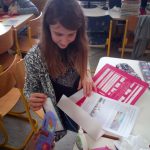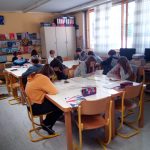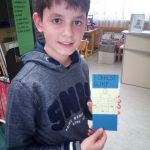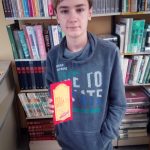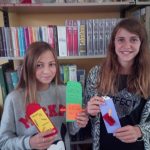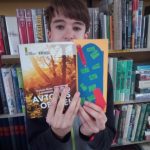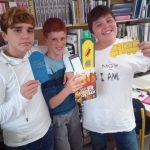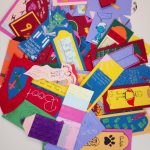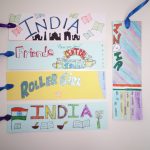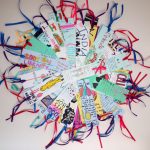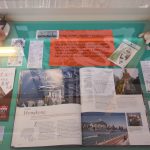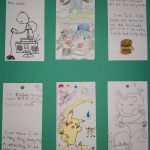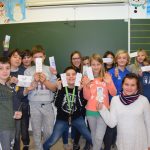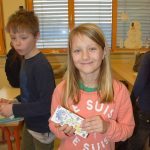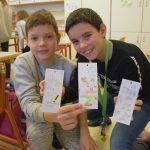The English translation for our partner schools, provided by the English teacher David Stegu, is available under the original text.
Odkar smo izmenjavo knjižnih kazalk zaključili, je minilo že več mesecev. Še vedno pa dolgujemo prispevek, obljubljen letošnjima sodelujočima šolama.
Komaj se je lanska, in hkrati naša prva, izmenjava jeseni 2017 končala, smo se že veselili nove. Dočakali smo jo in učenci so jo ponovno sprejeli odprtih rok. Tisti, ki so jo poznali že od lani, so ji bili še toliko bolj naklonjeni.
IASL (International Association of School Librarianship) je oktobru, mednarodnemu mesecu šolskih knjižnic, tokrat za rdečo nit izbrala temo Zakaj imam rad svojo šolsko knjižnico (Why I Love My School Library). Organizacija še vedno pridno deluje v smeri promocije šolskih knjižnic. Na različne načine, z različnimi dejavnostmi in projekti se na mednarodni ravni trudi povezovati ter predstavljati šolske knjižnice kot žive ogranizme izobraževalnega procesa.
Izmenjava ročno izdelanih knjižnih kazalk je del njihovih dejavnosti omenjenega meseca. Oktobra 2018 so ji dodali novost – dve starostni skupini. Ker smo z lanskim sodelovanjem vendarle pridobili nekaj izkušenj, smo tokrat prijavili nekoliko večje število učencev, skoraj sto, in se vključili v obe starostni skupini. V mlajši je sodelovala skupina podaljšanega bivanja, 27 učencev 4. a in 5. c. V starejšo skupino smo vključili vse sedmošolce, nekaj manj kot 70 učencev.
Če smo lani v šoli imeli predvsem predstavitev sodelujoče države in projekta, kazalke pa so otroci, razen skupina podaljšanega bivanja, izdelovali doma, nam je tokrat zadevo uspelo izpeljati drugače. Želeli smo, da bi bile vse kazalke izdelane v šoli.
S tem namenom smo v 7. razredu izdelovanje umestili v običajni kulturni dan, posvečen projektu Rastem s knjigo. Vsako leto ga znotraj šole organizira vodja šolske knjižnice Mira Tratnik. Po obisku Mestne knjižnice in čitalnice Idrija smo se vrnili v šolsko knjižnico, se spoznali s prejetim knjižnim delom in osnovnim postopkom navanjanja virov, nato pa drugi del dneva, ki je navadno namenjen informacijskim virom in knjižničnim katalogom, odstopili projektu IASL-ja. Učenci so si lani izmenjali kazalke z indijsko šolo iz Ahmedabada. Starejše je tudi letos čakalo sodelovanje z Indijo, a z drugo, mednarodno neprofitno šolo za izseljence in domačine The British School, ki stoji v osrčju diplomatskega dela glavnega mesta New Delhija. Tisti, ki so projekt in državo že poznali, so imeli priložnost osvežiti si spomin, drugi pa so prvič sledili predstavitvi. Novo sodelujočo šolo smo spoznali skupaj. Leta 1963 jo je osnovala peščica britanskih staršev, ki je svojim otrokom priželela kvalitetno izobrazbo. Prvih 40 učencev je bilo šestih različnih narodnosti. Danes je pod streho združenih skoraj 60 različnih nacij. V šoli učijo po angleškem učnem načrtu, ustreznem mednarodnim standardom. Pravijo, da so unikatni, ker so več kot šola, so družina in v Indiji je družina na prvem mestu. Naklonjeni so vsem kulturam, a skozi proseva indijski duh. Imajo predšolski, osnovnošolski in srednješolski program, vključujoč otroke od 3. do 18. leta. Avgusta 2016 so dobili novo, moderno stavbo. Ko smo izvedeli, komu bomo kazalke poslali, smo se posvetili izdelavi. Letos učencev nismo pretirano omejevali. Seznanili smo jih z glavno temo meseca, dodali nekaj smernic, ki so jih lahko upoštevali ali pa tudi ne, nato pa so se že lotili samostojnega oblikovanja. Smeli so širše gledati na knjižnico. Lahko so uporabili ljubega knjižnega junaka, priljubljeno knjigo, kaj drugega, kar jih spominja na knjižnico. Veliko jih je uporabilo v angleščino prevedene pesmi Toneta Pavčka. Nastale so prav lepe in predvsem pestre knjižne kazalke. Izkazalo se je, da se večinoma vsi učenci, če delo poteka med poukom, potrudijo.
Mlajša skupina sodelujočih v projektu je bila 9. skupina podaljšanega bivanja. Njim je bila kot partnerska šola določena prostestantsko/katoliška šola C. C. C. Kei Wan Primary School iz Hong Konga. Prav veliko nam o njej ni uspelo izvedeti, imeli smo kar nekaj težav s spletno stranjo v njihovi pisavi, a vendar smo bili prijazno usmerjeni na nekaj video posnetkov šolskih prireditev. Šola svoje učence spodbuja k ciljem, ki dajejo smisel njihovim življenjem. Vlivajo jim ljubezen do učenja, kulturo za odličnost, z njimi delijo svete resnice, moralne vrednote, kritične, analitične spretnosti in jih vodijo, da bi postali odgovorni državljani ter učinkoviti voditelji pristnega krščanskega duha v vedno spreminjajoči se družbi. Barvita šola s štiriindvajsetimi oddelki, ustanovljena leta 1970, je locirana med visokimi stolpnicami Hong Konga. Njihovo vodilo je biti discipliniran tekom učenja in razumeti Kristusova načela. Hong Kong smo z učenci spoznali kar v podaljšanem bivanju, prav tako, enako kot lani, smo tedaj izdelovali tudi kazalke. Ni šlo niti v enem dnevu in niti oktobra, potegnili smo v del novembra. Narava podaljšanega bivanja je pač taka, da vsi učenci skoraj nikoli niso prisotni, saj hitijo vsak na svoje popoldanske obveznosti ali domov. Stanju smo se torej prilagodili. Mlajši učenci so izdelovali na podoben način kot sedmošolci. Starosti primerno so nastajale bolj otroške, a nič manj simpatične, stvari. V obeh skupinah smo pošiljkama dodali sporočilo tujima šolama, učencem in učiteljem v pozdrav.Indija je paketek hitro prejela, mi njihovega prav tako. V tekstu in likovni govorici so upodobili njihove najljubše knjige, se na kratko predstavili, vse kazalke popestrili s simpatičnimi pisanimi trakci. Preden smo jih z žrebom razdelili med sedmošolce, so bile razstavljene v vitrini šolske knjižnice v pritličju šole.Dlje časa je vzelo, da je naša pošiljka prispela v Hong Kong in tudi, da smo mi prejeli njihovo. V Idriji smo že skoraj obupali, ko smo se sredi decembra končno lahko razveselili pošte tudi iz te oddaljene dežele. Tudi honkonški otroci so se potrudili pri ustvarjanju. Naši učenci so bili navdušeni, ko so na marsikaterem izdelku opazili njihove zanimive črke. Te kazalke smo razstavili v vitrini poleg knjižnice. Šele s koncem januarja 2019 je nove lastnike tudi v tem primeru določil žreb.
Če smo se prejšnje leto ob izteku izmenjave veselili prihodnje, tokrat pričakujemo izmenjavo 2019. Pravijo, da je radovednost otroška lastnost, a tudi meni – knjižničarki in odrasli osebi – se zasvetijo oči, ko prejmemo pošto iz tujine ter nestrpno hitimo, da vidimo, kaj skriva ovoj.
- Kazalke nastajajo.
- Lan s svojo kazalko.
- “You should read,” pravi Val.
- Klara in Dunja s svojimi izdelki.
- Samuel s svojo knjižno kazalko.
- Zadovoljni z izdelki.
- Zbrane kazalke naših sedmošolcev.
- Učenci podaljšanega bivanja so spoznali sodelujočo šolo.
- Kazalke 9. skupine podaljšanega bivanja.
- Indijske kazalke.
- Razstavljene hongkonške kazalke.
- Veseli prejetih kazalk.
It has been months since we finished the bookmark exchange project. However, we still owe a report, which we promised to compile for our partner schools.
Our first exchange had barely finished in the fall of 2017 and yet we were already looking forward to the next one. It finally happened and students welcomed it again with arms. Those, who had been familiar with it since the previous year, were even more excited to participate again.
For October, as the international month of school libaries, IASL (International Association of School Librarianship) chose the main theme entitled “Why I Love My School Library”. The organization still works hard to promote school libraries. In different ways, with various activities and projects, it strives to connect and present school libraries on the international level as living components of educational process.
The exchange of hand made bookmarks is one of their activities for the aforementioned month. In October 2018, the activity was improved by being introduced in two separate age groups. As we had definitely gained some experience with the last year’s cooperation, we decided to register a slightly larger number of students this time, i.e. almost one hundred, and thus got involved in both age groups. In the younger group, we had the after school program group with 27 students from 4. a and 5. c (aged 9-10). The older group, on the other hand, included all the 7th graders (aged 12), altogether amounting to just below 70 students.
If last year the focus had been especially on presenting the partner country and project, while bookmarks were mostly (aside from the after school program group) made by children at home, then this time we were able to carry out the project in a different way. We wanted all the bookmarks to be made at school.
It was by this intention in mind that we chose one of the standard technical days of the 7th grade (which was dedicated to the project Growing Up with a Book) as the date for the creation of bookmarks. The project is organized annually at school by Mira Tratnik, the head librarian. After visiting Idrija Public Library, we returned to the school library, got acquainted with the selected literary work and the basic rules of citing sources and subsequently, the second part of the day, which is normally dedicated to information sources and library catalogs, was eventually given way to the IASL project. Last year, students exchanged bookmarks with their peers from the Indian School from Ahmedabad. The older students were going to cooperate with India this year as well, but with a different, international and non-profit school for migrants and locals, The British School, which is located in the heart of the diplomatic area of New Delhi, the capital city. Those, who had already been familiar with the project and the country, had the opportunity to refresh their memory while others attended the presentation for the first time. We learned about the new partner school together. In 1963 it was established by a handful of British parents, who wanted to provide quality education for their children. The first 40 students were of six different nationalities. Today, school is home to almost 60 different nations. They teach according to the British curriculum, which suits international standards. They say that they are unique as they do not perceive themselves solely as a school, but rather as a family and family plays a pivotal role in Indian society. They accept all cultures but they always maintain their Indian spirit. They have a pre-school, elementary and high school program, which includes children aged between 3 and 18. In August 2016, they constructed a new, modern building. After we had learned who we were going to send the bookmarks to, we focused on their creation. We did not put any special limitations on the students this year. We told them about the theme of the month, added some guidelines, which they were allowed to later either take into account or not and then they were already off to their independent design. We allowed them to have a broader perspective on the library. Many used poems by Slovenian author Tone Pavček, which had been translated into English. In the end, we finished with some pretty decent and especially diverse bookmarks. It turned out that most of the students try really hard providing that the creation process takes place during the lessons.
The younger group of participants consisted of students of the 9th after school program group. They were assigned a Christian school C. C. C. Kei Wan Primary School from Hong Kong as their partner school. Unfortunately, we could not learn a lot about it as we had quite a few problems with the webpage, which was only available in their ortography. However, we were nevertheless kindly referred to some of the videos of their school events. The school encourages its students to strive for the goals, which give meaning to their lives. They teach them to love learning, appreciate the culture of excellency, spread the message of the Gospel, pursue moral values and develop critical thinking along with analytical skills, consequently leading them to the ultimate goal of becoming responsible citizens and efficient leaders of Christian spirit in an ever changing society. It is a colorful school with twenty-four departments, established in 1970 and is located among the tall buildings of Hong Kong.Their motto is to be disciplined during the process of learning and understand the principles of Christ. We got to know Hong Kong during the after school program lessons and just like last year we were also creating bookmarks in that time. We could not finish either in one day or even in October and for this reason we postponed the activity into November. The nature of the after school program simply does not provide many opportunities when all the students are present as they usually all rush either to their respective afternoon activities or simply go home. We therefore adjusted to the situation. The younger students were making the bookmarks in a similar fashion as their older peers. According to their age and skills, they produced simpler but no less lovely items. In both groups, we also added a message for both schools in order to send greetings to their students and teachers.
India quickly received our package and so we did theirs. It was by texts and drawings that they described their favorite books, gave a quick introduction and made all bookmarks even more interesting by nice and colorful ribbons. Before we organized the lot to distribute them among the 7th graders, they had been exhibited in the display case of the school library on the ground floor.
On the contrary, it took more time for our package to reach Hong Kong and the same applied for theirs to reach us. After we had almost given up hope in Idrija, we were really happy to finally receive the package in December also from this distant land. The children in Hong Kong also worked hard and produced beautiful products. Our students were thrilled when they spotted their interesting and intricate letters on many of their bookmarks. These bookmarks were put on display in the case next to the library. It had not been until the end of January 2019 that we selected their new owners by another lot.
If by the end of the previous exchange we were already looking forward to the next one, then this time we are already anticipating the 2019 exchange. They say that curiosity is the trait of a child, however it is also my eyes – those of a librarian and an adult – that shine after we receive the package from abroad and then anxiously rush to see what is inside.
David Stegu, Martina Vidmar

